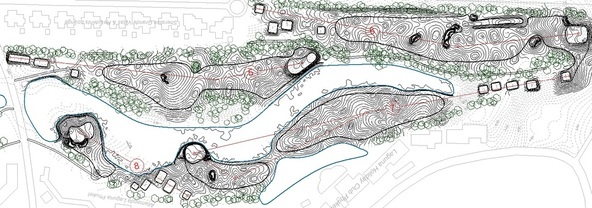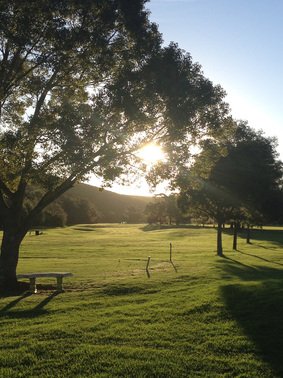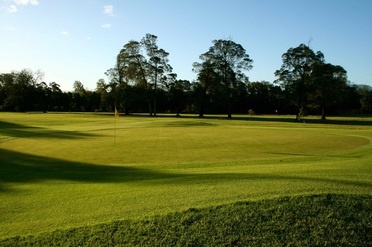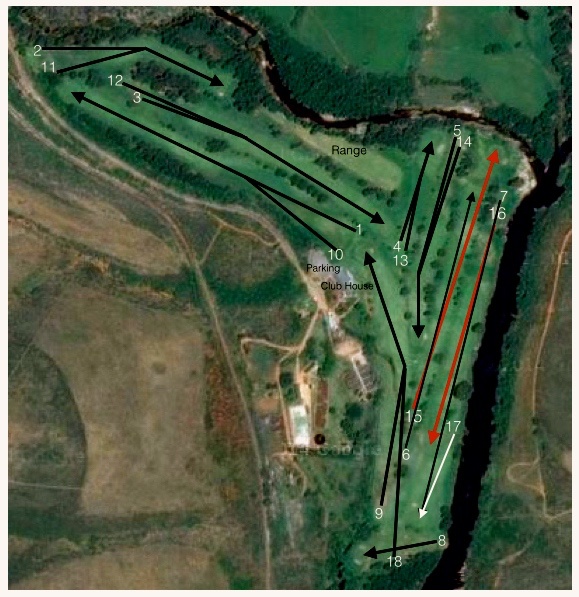GOLFING in RIVERSDALE
Very scenic Golf course in Riversdale.
Contact Details
Tel: +27 28 713 3056
Fax: +27 28 713 3056
Email: [email protected]
KINDLY REQUEST STAFF AT FYNBOS GUESTHOUSE TO ASSIST WITH BOOKING AT CLUB
History
Riversdal Golf Club as a very rich history and in 2011 we celebrated our 100th year anniversary. However, to have come to that astonishing century our club had to have begun somewhere and if you have time please read our story:
Our story starts way back in 1911, when the first man in Riversdal to swing a golf club was Maans Jannie Steyn. He only had one golf club, just like many of us when we started out, but he went out every day and hit a couple of golf balls in the land surrounding his home. At a council meeting on 8 May 1911, Mr. Attmore and Mr. Denysson handed in an application for the development of a golf course in Riversdal. After careful consideration the council approved the development of Riversdal Golf Course.
On 19 May 1911, a founding meeting was held in the Riversdal town hall and the first committee was chosen for Riversdal Golf Club. The committee were as follows:
President - D. Versveld
Vice-President - F. Dawson
Additional Members: F. Wége, M. J. Botha, and D. J. Roux
Since then, Riversdal Golf Club has had to make way for the expansion of a Riversdal neighbourhood in 1928 at which time the golf course was relocated to where Oakdale Agricultural High School is today. In 1932, Dr. Pieter Daneel donated a stunning silver trophy which was the only one of its kind at that stage. The idea was to attract more golfers to the areas where there were only 9 hole course, as well as increase competitiveness between golfers. The Daneel Trophy as it is still known as today was played for between Albertinia, Riversdal, Heidelberg, Ladismith, Swellendam, and Montagu. However, since then Albertinia, Ladismith and Montagu have withdrawn from the Daneel Trophy and was replaced with Robertson, Bredasdorp and Riviersonderend.
After the war, Gerhard de Vries took it upon himself to find a new suitable location for our precious gem, and came across wetlands with a river that run all along the left of it. Since that day, Japie Dekenah and Gerhard de Vries went down to the wetlands and started cleaning the area, and removed any and all unwanted bush.
On 12 March 1945, Councilor, E. Theron applied for the use of the wetlands by Riversdal Golf Club at the municipality. On 25 June 1945, Councilors A. J. van Wyk and A. H. Karremacher proved the use of the wetlands by Riverdal Golf Club. Mr. de Vries and Mr. Dekenah then went ahead and started constructing the first green. In the year 1952 Riversdal Golf Club got it first club house, which was not very big and could only be used for entry at the golf club, however the total of the club house was a mere R480 to build. It was in 1965, that the wooden club house was burnt down due to a "braai" that was held to close to the club house. It was only in 23 September 1967, that Riversdal Golf Club had a new club house after Mr. Eddie Davids built a new club house where it still stands today. However, due to a influx of new golfers the members at Riversdal decided to expand the club house and enlarge it, as well as to obtain a liquor license.
The captain of that time, Mr. Danie van Tonder, was the one with the driving force to see the club succeed and expand, as well as improve our golf course. Today, we have probably the best, most scenic, and challenging 9 hole course in Southern Africa.

The Course
Riversdal Golf Club boasts a 9 hole, 18 tee golf course, even though we are actually a 11 hole course, which has been rated one of the most scenic in South Africa. Riversdal Golf Club has an intimate and friendly atmosphere and is a small gem along the Garden Route. The course plays very challenging even though one might feel otherwise upon first glance. Our lovely course is a Par 72 course covering a distance of 5844m for men and 5049m for ladies.


Please see below our hole-by-hole descriptions and course layout. Ladies tees are marked with parentheses.
Hole 1 (389m Par 5)
The first hole is a straight forward 452m par 5, however driving the ball straight down your own fairway may come as a challenge.
Hole 2 (292m Par 4)
The second is a 292m par 4 with a dogleg to the right. One might think "this hole is drivable", but with water on the left and the tall trees along the right of the fairway blocking the green, you can land into some trouble.
Hole 3 (315m Par 4)
The third is again a straight forward 375m par 4, but with the big trees on both sides of the fairway, one could turn it into a par 5 or 6 if not careful.
Hole 4 (147m Par 3)
The fourth is the second longest of the par 3s measuring 159m. Quiet an easy hole if you hit the green and with wind almost always from the right you could end up in the woods or the green side bunker if you start it to far right.
Hole 5 (248m Par 4)
The Fifth is a drivable 293m par 4 for the long drivers. It is a relatively easy hole with no real danger.
Hole 6 (309m Par 4)
The sixth is a 365m par 4, playing to the front of the two green in this fairway. It is also a very straight forward hole except if you hook or slice our ball, because you make the hole much longer than it should be.
Hole 7 (393m Par 5)
The seventh is a challenging 475m par 5, playing to the second green on this fairway. With water all along the left and hook for the right handed golfer could spell trouble.
Hole 8 (125m Par 3)
The eighth is the shortest hole on the course measuring only 126m. This has been one of the easiest holes for a number of year, but with probably the green that slopes the most it provided a good challenge.
Hole 9 (317m Par 4)
The ninth is a 382m par 4 with a dogleg to the left. With out-of-bounce almost all along the left of the hole many a brave soul has fallen short when trying to drive over the corner of the dogleg.
Hole 10 (389m Par 5)
The tenth play slightly shorter than 1 at 451m. However, this par 5 doglegs to the left and striking the ball over the corner of the dogleg could set you up with a good birdie or par chance.
Hole 11 (282m Par 4)
The eleventh is a 282m par 4 with a dogleg to the right. Playing very much the same as hole 2 one might think "this hole is drivable", but with water on the left and the tall trees along the right of the fairway blocking the green, you can land into some trouble.
Hole 12 (340m Par 4)
The twelfth is a 413m par 4. Playing a bit longer an 3 one might think you have this one in the bag, but time and time again the twelfth has shown that it deserves to be the most difficult hole on the course.
Hole 13 (147m Par 3)
The thirteenth is the longest of the par 3s totalling 172m. Playing to the same green as hole 4 there is not much stopping you to make a par except yourself.
Hole 14 (248m Par 4)
The fourteenth plays exactly the same as hole 5, also making it drivable for the long drivers.
Hole 15 (309m Par 4)
The fifteenth is a 355m par 4. Playing to the back green on this fairway one can get into trouble with you second or third shot into the green as there is water along the back of the green and a green side bunker on the right.
Hole 16 (281m Par 4)
The sixteenth is a 353m par 4 playing to the front green on this fairway. Playing on the same fairway as hole 7 there will be water all along the left and you shot selection has to be spot on.
Hole 17 (137m Par 3)
The seventeenth is the last of the four par 3s measuring on 151m, it is the second easiest hole one the course. Besides for the green side bunkers on the left and front right of the green, getting the ball close and making a par should be quiet easy.
Hole 18 (381m Par 5)
The eighteenth is a 455m par 5. With out-of-bounce all along the left, which is the same as hole 9, is doglegs to the left and does play quiet long if you land behind the many tree along the right of the fairway.
Article source Kind permission J Nel Riversdal Golf Club 2016

Share This Post